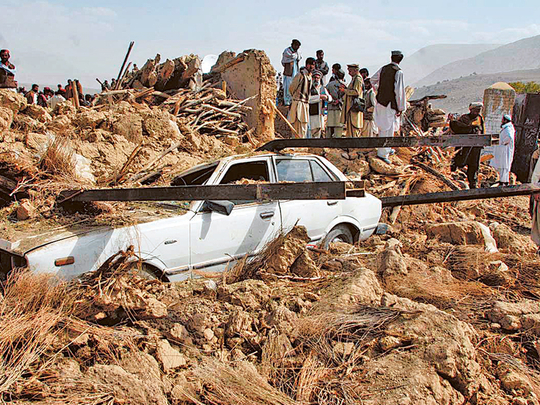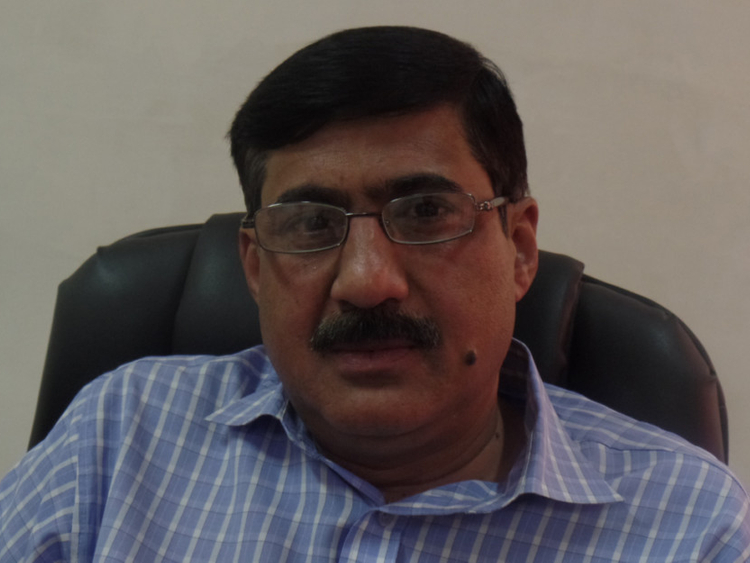
“Because of geographical [sic] changes, Pakistan is facing severe earthquakes. So are homes really safe?” asks the voice in a television advertisement for steel bars. The advertisement, which started being aired recently, comes in the wake of earthquakes that have rocked the country since last October. The manufacturer’s claim is that the use of “European technology” gives these bars the “strength and flexibility to fight every jolt from the earthquake”.
Ironically, in a country where a significant portion of the population lives below the poverty line, not everyone can afford “European technology” steel bars. In fact, many still live in “kuchcha” houses, or houses built of mud, wood or straw. Gul Hamaad Farooqi, a journalist from Chitral, northern Pakistan, lived in one such kuchcha house. His home was destroyed in the powerful 7.5-magnitude earthquake that struck the region on October 26, 2015. Farooqi was not at home at the time, but his family was. “I was jolted to the other side of the road. It was that powerful. I was worried about my children,” he says.
The earthquake, whose tremors were felt as far as Tajikistan, India, Nepal, Uzbekistan and Turkmenistan, killed more than 300 people in Pakistan and Afghanistan. Many more were injured and buildings were destroyed. The mountainous region of Chitral was among the worst hit due to its proximity to the epicentre in the Hindu Kush region of Afghanistan. Fortunately, Farooqi’s family managed to escape.
The aftermath and the authorities’ attitude towards the victims have, however, left him bitter. “In our media there are people whose conscience is dead. They have a lot [of wealth.] But those who have a conscience are suffering like me, still living in kuchcha houses,” he tells me.
Pakistan lies in one of the most earthquake-prone regions in the world. In 2005, a 7.5 magnitude earthquake in Pakistan-administered Kashmir killed 75,000 people. Last year’s earthquake had a similar magnitude, but because it originated around 200 kilometres below the Earth’s surface, the casualty figures were significantly less than the one in 2005.
What’s alarming, though, is that since the earthquake in October, there has been a spike in seismic activity in the region. On December 7, there was a 7.2-magnitude quake with its epicentre in nearby Tajikistan. Then on December 25 there was a 6.9-magnitude quake in Badakhshan, Afghanistan. On January 2, Islamabad was shaken by a 5.8-magnitude earthquake whose epicentre also lay in the Hindu Kush region. On June 15, an earthquake of 5.4 magnitude jolted parts of north western Pakistan, while more recently a 4.9 magnitude quake was felt with its epicenter near Lahore on July 17.
To find out what’s going on, I met Zahid Rafi, director of Seismology at the Pakistan Meteorological Department, who knows more than most people about earthquakes in the region. Sitting in his office in Islamabad, Rafi talks about how unusual the recent seismic activity has been. “Even if there are one or two over 7-[magnitude] earthquakes in a year, it is very dangerous.” Earthquakes measuring 7, or even 6, on the Richter Scale are not that frequent, and it takes a lot of time for geological processes to build that kind of pressure up, he explains. “But such high-magnitude earthquakes have started occurring more frequently now.”
Rafi was in his office when the October earthquake struck. “Our network recorded [a reading of] 8.1. However, other agencies in the world recorded a lower magnitude. Everyone has their own technology,” he says. The US Geological Survey measured the same earthquake at 7.5. “At that time there was a lot of controversy. The difference [was because] we are a lot closer to that area ... there can be different readings. One reason is how far or close you are [to the earthquake]. In seismology, the closest station gives the best recording.”
The occurrence of high magnitude earthquakes in Pakistan was fairly spread out earlier. “In more than 80-90 per cent of the earthquakes, the potential used to be between 4 and 5,” he tells me. “A 6-magnitude quake would occur in about a decade, and it would take 15 to 20 years for it to cross 7.”
The past few months appear to have challenged the traditional pattern of seismic activity. “This area’s previous study structure was based on statistical analysis. But the theory deviates a bit since the earthquakes post-October 26. It’s not necessary that a big earthquake won’t happen again in an area where one such event has already occurred. Since there have been frequent earthquakes in a span of five or six months, this area becomes more vulnerable.”
With the heightened potential for earthquakes in the region a more proactive strategy is needed. According to one newspaper report, the October 26 earthquake may have reactivated dormant fault lines. “When there is such a big quake — more than 7.5, even crossing 8 — it means that there’s a lot of activity in the tectonic plates,” says Rafi.
Of particular concern now is earthquake-proof construction. Rafi, who studied at the International Institute of Seismology and Earthquake Engineering at Tsukuba in Japan, recalls the impressive earthquake-resistant architecture he came across there. “The roads there are undulating, in the shape of a wave. They do not develop any cracks during quakes because of the material used ... [While in Pakistan] we use a lot of concrete and bricks. And bricks are quite weak against earthquakes, and this results buildings collapsing.”
Another serious problem is the lack of adequate compensation to victims of natural disasters. In April, around 450 families from Chitral marched to the Afghanistan border with the intention of crossing over. They were stopped by the Chitral Scouts, the local paramilitary force. For decades, it was Afghan refugees who have fled conflict back home and found shelter in Pakistan. So, this was their way of registering protest and disappointment with the local district administration and the Pakistan government for failing to compensate them after the October earthquake. “They are disappointed with our government because they say the government does not consider them Pakistani,” Farooqi says.
There have been other protests over the issue in Chitral as well. Although the government announced compensation for people who were affected, many complained of not receiving the payment. Farooqi says he was one of them, all because “I write against the government”.
“Osama Ahmad Waraich, the deputy commissioner of Chitral, told me: ‘You enjoy writing negative news about us, so we are not giving you this cheque’. I said, ‘You are enjoying taking revenge against me. I don’t want your cheque. I may be poor, but I am not without conscience. I have self-respect’.”
So is it the federal government the or provincial government in Khyber Pakhtunkhwa that is holding back compensation? “The federal government [and the] provincial government had sent the money for the affected. But these people distributed the money those who had suffered no loss, leaving those who were deserving in the balance.”
Farooqi tells me about Shahzada Sikander ul Mulk, who belongs to the erstwhile royal family of Chitral. “He is the grandson of the king of Chitral. He told me that these people were trying to give him a political bribe.” Mulk, who did not suffer any loss in the quake, was offered a cheque but he turned it down, advising the officials to give the money to the needy, he says.
Farooqi alleges that some journalists were called to the local press club and offered money to keep mum. “They gave the press club Rs200,000 [Dh7,008] cheque to tell them to be quiet and not say a word against the authorities.”
Farooqi explains how the system works — or doesn’t. He cites the example of a labourer who has connections with a local councillor. The labourer was handed a cheque. “He said, ‘Sahib, this is all about relationships. You should also get a sifarish [intercession]. You will also get Rs200,000 cheque.”
Farooqi recalls the deep psychological impact the earthquake had on his family. “It was quite a cold winter, and then there was the snow. Normally, we close the door and light a fire inside our rooms. But after the quake, the children were so scared that they would not let us close door lest they get trapped if another earthquake strikes. So we’d spend the nights in intense cold.”
Then there’s a section of people in Pakistan that associates religion with the phenomenon of earthquakes. The Urdu word for earthquake is “zalzalah”, which is derived from Arabic and is also found in the Quran. It’s not uncommon for some people to distort the religious context, claiming that these natural disasters are divine punishment for sins.
I ask Rafi what he makes of these statements. “This is just superstition,” he says. According to Rafi the notion that earthquakes are the result of people’s sins does not have a basis in Islam. “It happens when you gravitate towards religion too much, and you push back science. When does our religion forbid the study of science or looking at the realities? Only when you confront a reality can you address it ... When you are living in an earthquake zone, adapt your lifestyle also. God has given you intelligence, a brain, [and He has] given you everything.”
Syed Hamad Ali is a writer based in London.














